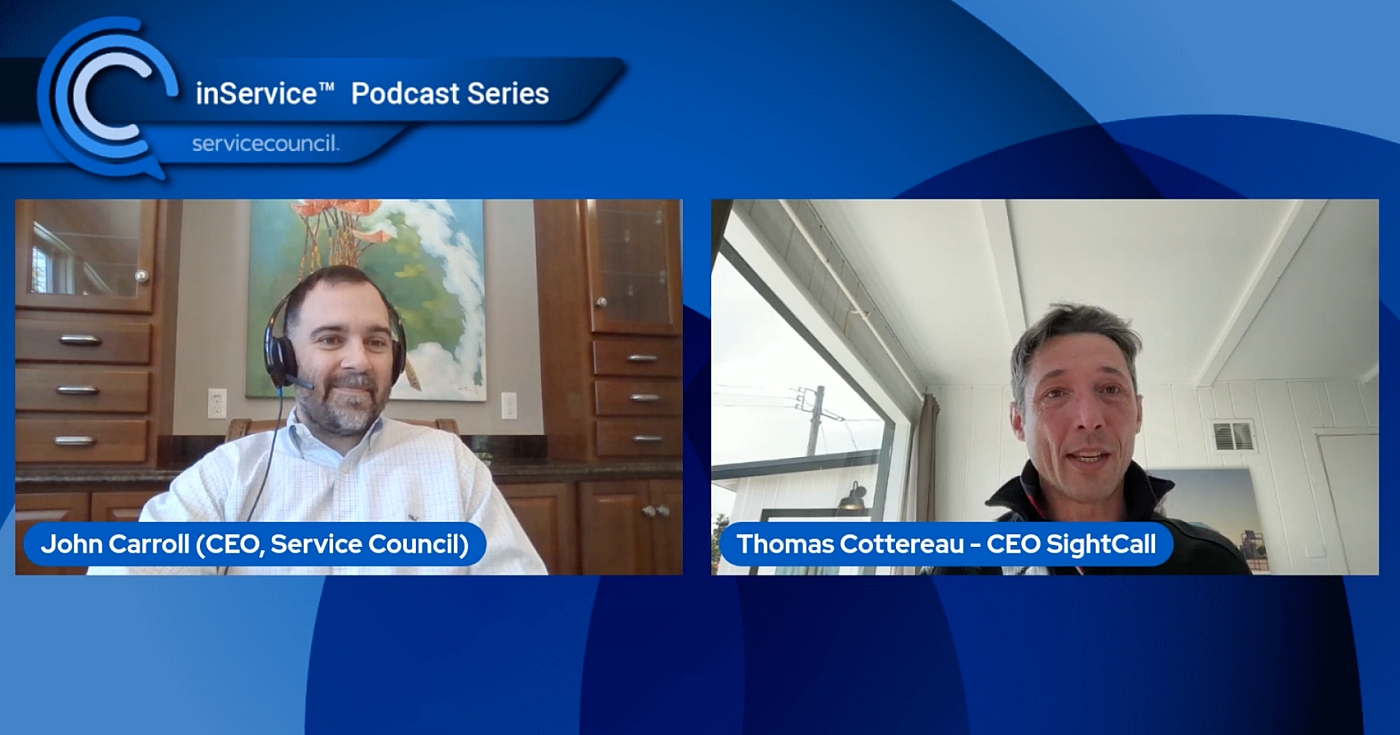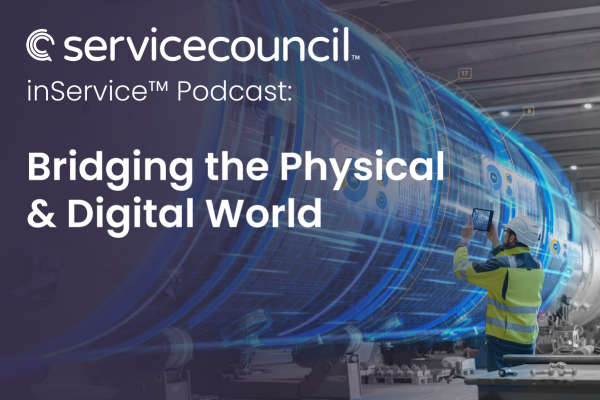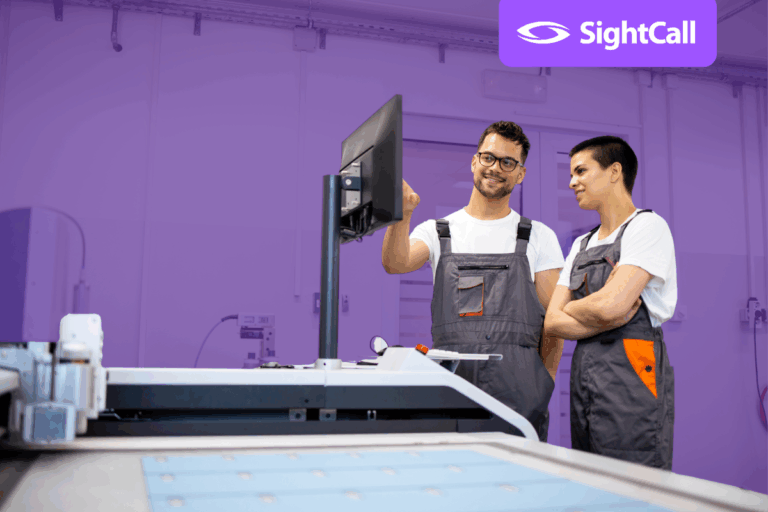Highlights from the inService Podcast Interview with SightCall CEO Thomas Cottereau

Service organizations are going through big changes.
It’s a time of tremendous challenges and equally massive opportunities for companies who are ready to innovate and embrace new technologies.
I recently appeared as a guest on the inService Podcast Series, hosted by Service Council CEO, John Carroll.
The topic was “Bridging the Physical & Digital World.”
Our conversation included advice about how organizations can address gaps in their digitization efforts, the evolution of customer relationships and the findings from Service Council’s recent parts management survey.
Here are six highlights and my key takeaways from the episode:

Customers want more, but companies are having to do more with less.
Efficiency is the real challenge.
Last year, I traveled the world to meet with our top customers. I can tell you that “having to do more with less” is a common trend everywhere.
Companies are trying to deliver the best customer service experience while having this constant pressure on cost, on resources, and dealing with the talent shortage in field service organizations.
Not only are they facing these economic pressures, but they are also facing higher expectations from customers wanting more immediate solutions.
When you order something on Amazon, you take out your smartphone. After three clicks, it’s in your cart and you know it will be delivered tomorrow.
That’s the kind of service that they expect.
When you want a driver, you click on Uber and you’ve got a car. And you can track the car as it comes closer.
That’s what field service customers expect now.
When a machine is not working as expected, they want the same seamless service experience as they would have in their personal life using Amazon or Uber.

The best systems connector is a human being.
Remember 20 years ago, when we thought that IoT would be everywhere?
That every piece of equipment would be connected and would communicate to the internet?
Unfortunately, we’re still in a world where most of the equipment that our field service teams have to manage, maintain, and install, is not connected to the internet (or only part of them is connected).
The challenge we’ve had to overcome is wanting to be more proactive in servicing this equipment, but also accepting that much of this equipment is not in the digital world yet.
That’s why we need to create a bridge between this equipment and all the software tools and applications we have on computers and smartphones.
Your CRM, your field service management software, your ERP, your asset management… Each of them has their own specificity that helps your customer and customer contract.
Unfortunately, odds are good that your asset management is not directly connected to your CRM. Most systems are still siloed.
But we found that a good way to connect these systems was with a human.
Use the person on site who has the equipment in front of them and their smartphone with all these digital tools.
Leverage the unique capabilities of smartphones that we all have in our pocket: the back camera, the screen, the computing power, and the connectivity.
The camera is used to see and identify the parts and equipment in front of the technician and a remote expert (or AI engine) on the other end can guide them.
We help update and connect to your digital software, so all tasks related to the work order can be completed within the same context.

Integration has become easier than ever before.
I remember the last Service Council symposium in Chicago.
The technology group came into the room where the field service leaders were, and asked, “How can the technology group can help you better in your transformation journey?”
And the first thing that came up was integration.
When you service equipment, your job is not to work on connecting software.
That’s part of our responsibility as software provider.
Twenty years ago, you would have utilized a big IT team and system integrators. It would be a massive project that took a lot of time to connect everything and build a system to fit your business needs.
Today, we’ve moved this responsibility to the cloud service providers. And there are standard protocols that we can all use to create APIs.
APIs connect systems together.
How we connect is well defined right now. The smart platforms are also leveraging this type of “API first” momentum.
Each time we meet with a provider that we need to connect with, the standards are straightforward. It takes a matter of hours to get the platforms connected.
We can interconnect with everything that has an API, and it’s not that complex. It goes fast and should not cost much.

The goal of digitization, digitalization, and digital transformation is to create value.
Digitization is something that happened in the past 20 years where you had all these paper manuals that you wanted to convert into digital manuals.
There was a lot of scanning large books to get them into PDF format and make them available to employees or customers when they needed to access them through their smartphone or computer, instead of having to ship a book, right?
That was the big piece of the digitization era.
I still see a lot of pens and paper in the field. So, we’re not a hundred percent done with digitization, but I think we are already well advanced in this process.
The one that happened next is digitalization.
Digitalization is about developing processes and changing workflows to improve manual tasks.
You take this manual action that you had to do in the past and see how it can be streamlined either directly by machine or guided through a digital tool for the person to follow this process.
The third layer is digital transformation. Digital transformation is a terminology that is maybe has been used too much, right? We know that it’s all over the place. Digital transformation is kind of the Holy Grail, right?
Everybody wants to go through digital transformation.
So, what is it?
Digital transformation is all about leveraging this knowledge and integrating it into business areas to enhance engagement and create value.
You take what you have, what you do today, and bring it to another level through digital platforms to create new value, new value offerings.
For example, building 24/7 service with visual assistance.
Instead of having to dispatch a technician on-site, you can have experts provide a guided experience on a 24/7 basis that you could not do with your technicians.
We have had clients deploy 24/7 support with a kind of a follow-the-sun model, using different locations around the world. That way, even if someone has a problem at 4:00 AM, it’s always daylight somewhere in the world.
Their customers can always connect with someone who can help and guide them.

Transparency always improves the customer experience.
By connecting the physical and digital worlds, you can get better communication and information.
I met with one of our customers last month and they shared that not having their asset management connected to their CRM was one of their big pain points.
A customer would call to let them know a part needs to be replaced.
But they would tell the customer that the new part should arrive “within one or two weeks.”
That answer worked before COVID, when parts delivery was kind of fluid.
During COVID, they had challenges with parts delivery and suddenly this answer was not valuable anymore. And the customer would call back a week or two later, saying, “you told me I should receive my part within two weeks. I don’t have it.”
The company can only say, “I’m sorry maybe it should come this week.”
But they have no visibility there.
And you can imagine how unhappy this customer was after 12 weeks of calling customer support every week to check the status of the part.
If the customer service agent had access to trackability, they could’ve set the right expectation upfront.
Transparency is the new customer expectation. Companies can’t afford to be blind anymore. Connecting the systems and communicating to the customer is how you improve the experience that you deliver.
There’s one statistic that I loved in the Service Council survey about parts management/parts delivery.
24% of unsuccessful service visits are due to not having the right part on site.
This is a perfect example of things that we can fix, right?
Why would the technician go on site without having the right part? There could be 50 different reasons and circumstances, but it should not happen.
If we can track and identify this part and connect the systems, we can make sure that the part will be there when this technician goes on site.
And we can make certain that this part will be the right part.
These are the kinds of problems that can be solved by connecting physical assets to your digital systems.

Cutting costs can impact more than just the bottom line.
Everybody wants to measure the value of a new system, which makes complete sense. And we love to implement metrics dashboards and reporting to measure this value.
I can tell you that with most of our customers, the ROI is demonstrated in less than two months.
In terms of truck rolls, the cost can go from $250 to over $2,500 per dispatch depending on the distance, the duration, and the type of transportation. In terms of showing value, it’s a simple calculation that we can do each time we save a truck roll.
What’s the average number that we see across the board?
I can tell you the large field service organizations that implement SightCall, literally cut more than 50% of their truck rolls.
This number is massive. That was not even my goal when I started the company. I discovered it later.
Why do we have such a massive impact?
Well, what I saw across these deployments is that most onsite visits are not a visit where you effectively perform an action, a physical repair on the machine. There are a lot of pre-visit troubleshooting and post-visit inspections, and of course, the visits that are not successful the first time.
Now, instead of sending someone to do a pre-visit or assessment, you can remotely engage the customer directly or connect to the person in front of the equipment.
These pre-assessment calls can save an onsite visit most of the time and allow you to collect all the information you need.
You can leverage your customer’s smartphone, even if they are not within your organization, to help collect the information that you need.
Optical character recognition or AI image recognition capabilities are available through their phone. This helps you identify exactly which part is there, which equipment, and what the problem is.
You can collect all this data, so that when the technician does go on site, they know exactly what’s going on.
The other impact I love is how we support sustainability and reduce the carbon footprint.
We generate a CO2 report for our customers every time they save an onsite visit.
We can map it to a global database and calculate the distance traveled based on the type of vehicle that they have and the type of road. We know the gas consumption and use all this data to figure out the carbon savings.
So, preventing an onsite visit also has a very strong impact on our planet.



